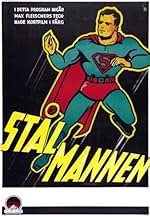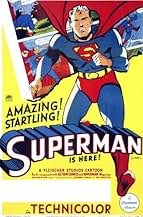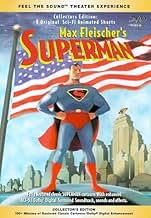Füge eine Handlung in deiner Sprache hinzuThe Man of Steel fights a mad scientist who is destroying Metropolis with an energy cannon.The Man of Steel fights a mad scientist who is destroying Metropolis with an energy cannon.The Man of Steel fights a mad scientist who is destroying Metropolis with an energy cannon.
- Für 1 Oscar nominiert
- 1 Nominierung insgesamt
- Clark Kent
- (Synchronisation)
- (Nicht genannt)
- …
- Lois Lane
- (Synchronisation)
- (Nicht genannt)
- Perry White
- (Synchronisation)
- (Nicht genannt)
- The Mad Scientist
- (Synchronisation)
- (Nicht genannt)
- Narrator
- (Synchronisation)
- (Nicht genannt)
Handlung
WUSSTEST DU SCHON:
- WissenswertesMax Fleischer and Dave Fleischer were reluctant to take this assignment because it would require much more realistic designs and animation than they usually used. They tried to discourage Paramount by stating they would need a budget of around $100,000 per short, four times the budget of an average Walt Disney cartoon, which then had the highest budgets in animation. To their shock, Paramount executives agreed to at least half the amount, which made the Superman series--in adjusted dollars--the biggest-budgeted animation series in film history.
- Zitate
[first lines]
Voices: Up in the sky, look: It's a bird. It's a plane. It's Superman!
Narrator: [opening narration] In the endless reaches of the universe, there once existed a planet known as Krypton, a planet that burned like a green star in the distant heavens. There, civilization was far advanced and it brought forth a race of "supermen," whose mental and physical powers were developed to the absolute peak of human perfection. But there came a day when giant quakes threatened to destroy Krypton forever. One of the planet's leading scientists, sensing the approach of doom, placed his infant son in a small rocket ship and sent it hurtling in the direction of the Earth just as Krypton exploded. The rocket ship sped through star-studded space, landing safely on Earth with its precious burden: Krypton's sole survivor. A passing motorist found the uninjured child and took it to an orphanage. As the years went by and the child grew to maturity, he found himself possessed of amazing physical powers. Faster than a speeding bullet, more powerful than a locomotive, able to leap tall buildings in a single bound. The infant of Krypton is now the Man of Steel: Superman! To best be in a position to use his amazing powers in a never-ending battle for truth and justice, Superman has assumed the disguise of Clark Kent, mild-mannered reporter for a great metropolitan newspaper.
- Alternative VersionenIn the scene in the editor's office, when Lois Lane runs off to "follow up her lead," Clark Kent originally asked Perry White, "Don't you think that's a dangerous mission for a girl?" In most current prints, the scene is cut so that the line now ends on the word "mission."
- VerbindungenEdited into Fantastic Animation Festival (1977)
1. The Superman cartoons formed the first action/adventure/sci-fi cartoon series ever, thus setting the stage for all anime, Saturday morning TV action 'toons, video games and such to come.
2. The Superman series quietly helped disseminate art-deco and other modernist design styles into popular culture.
3. "The Arctic Giant" episode predates the 'giant dinosaur' film cycle by some ten years; the design of the Arctic giant itself was clearly an inspiration for Toho's Godzilla design.
4. The drawing style for the Superman comic books was rather rough, as with most action comics of the type of that era. The Superman cartoons, on the other hand, present a smooth-line style, using dark shadows for modeling. This style was to have a great impact on the "illustrated novel" comic book style that developed in the late '70s - roughly about the time the series was rediscovered by comics/cartoon fans.
5. Fleischer studios apparently simply ignored the Superman live-action serials of the time. Thus rather than pursing convoluted plots only resolved by dialog, they chose a compressed narrative style, with hardly any dialog, which emphasizes the plot as realizable only through action.
6. Because of this compressed narrative style, the Fleischer story writers were the first to be confronted with the perennial Superman dilemma - namely, how to actually threaten a character who is all-powerful and invincible at least to the extent of creating a plot-motivating conflict. They are not always successful - the episode about the escaped circus gorilla is especially unconvincing - but the effort is fascinating, especially since the comic book Superman writers would not really confront the problem until the 1970s (having used the kryptonite ploy to evade the issue for 20 years).
7. Interestingly, the Fleischer Superman series, with its stronger violence and deeper themes, and its commitment to a kind of visual realism, is clearly intended for a more mature audience than the comic books or the live-action serials - despite the fact that it appeared just as major studio cartoon workshops began resigning themselves to entertaining younger audiences.
8. "The Eleventh Hour" episode, with Superman acting as saboteur in a personal war against Japan, was released nearly 3 weeks BEFORE Pearl Harbor. The Fleischers thus had Superman join the fight against Fascism world-wide before the US was finally drawn into the battle.
9. It is true that the cartoon series defines its character and history differently than the comic book version; but this was when the Superman mythos was still in development, and the Fleischers pursued possibilities for the character the comic book writers had not yet considered (for instance, his ability to fly, his invulnerability, the curiously playful relationship between Clark and Lois - which in the cartoons has a real edge of adult romantic attraction that was unavailable to the comic book writers).
It is easy to see why the Superman series did not salvage the Fleischer studios from their ultimate dissolution - they are dark, violent snippets of science fiction drama at a time when audiences were coming to expect cartoon animals playing gags on each other. But it is more difficult to figure out why it lasted for as many episodes as it did. My guess is that the Fleischers realized they were breaking new ground, and were willing to give it as much a chance for success as possible. Unfortunately, they were literally decades ahead of their time. As a particular animated cartoon style, we would not see its like again until the Warner Bros. Batman television series of the 1990s - and by then the idiom was simply accepted as one of many available to animators and cartoon artists.
Top-Auswahl
Details
- Erscheinungsdatum
- Herkunftsland
- Offizieller Standort
- Sprache
- Auch bekannt als
- Superman: The Mad Scientist
- Produktionsfirma
- Weitere beteiligte Unternehmen bei IMDbPro anzeigen
Box Office
- Budget
- 50.000 $ (geschätzt)
- Laufzeit10 Minuten
- Seitenverhältnis
- 1.37 : 1
Zu dieser Seite beitragen

























